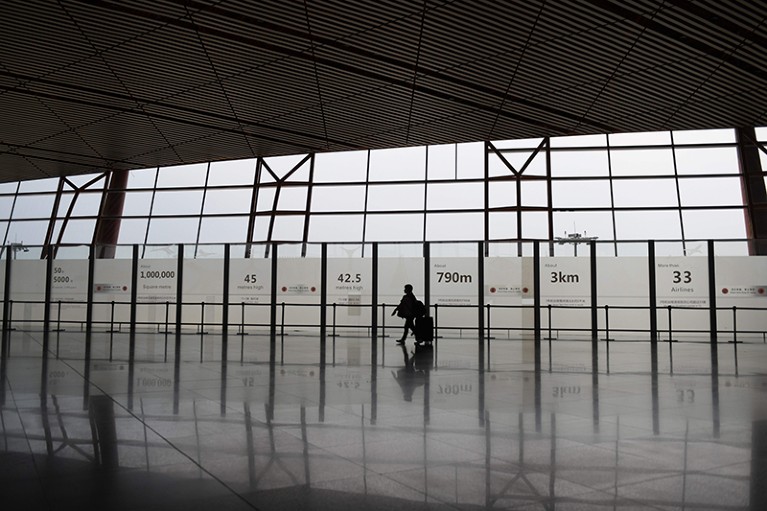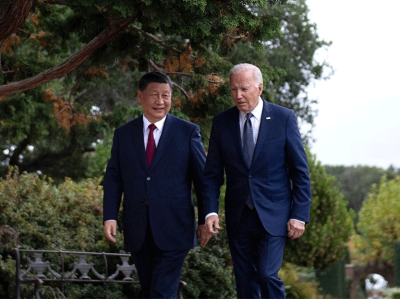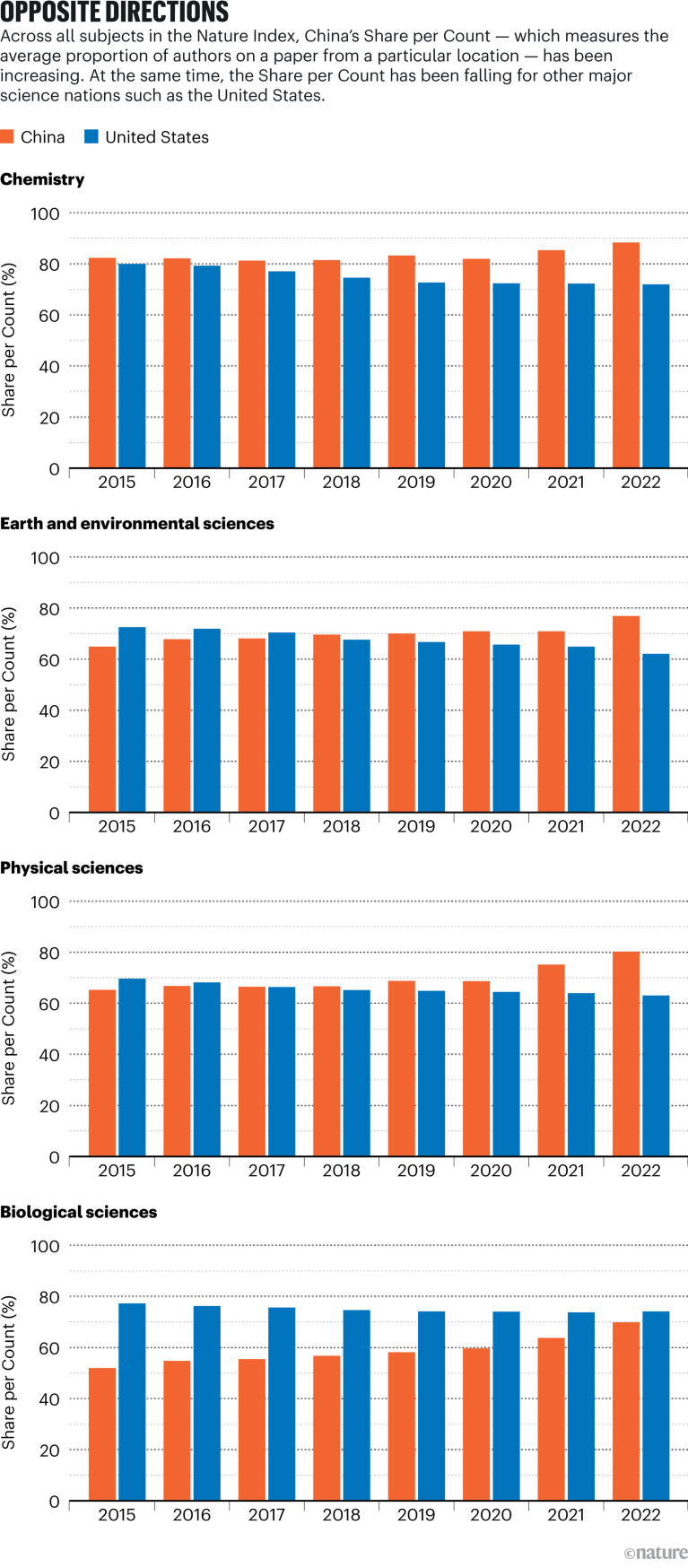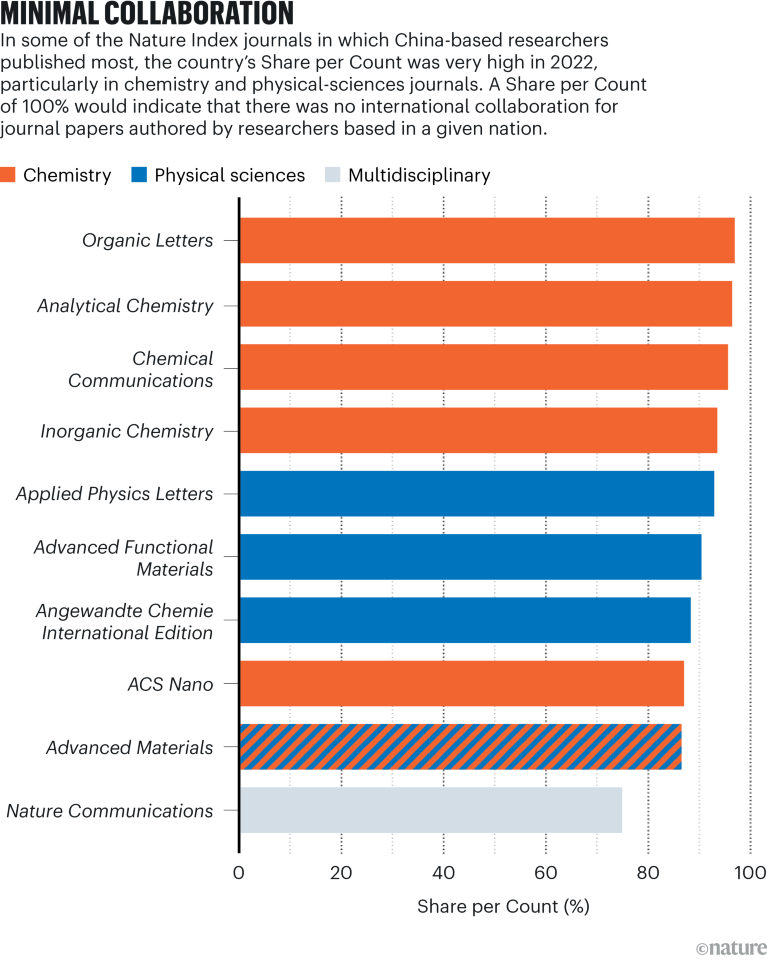
Travel restrictions during the COVID-19 pandemic are among the factors that have altered China’s patterns of international research collaboration.Credit: Greg Baker/AFP via Getty
When China overtook the United States in the Nature Index for contributions to natural-sciences research articles last year, it marked a watershed moment for the database and for Chinese science. Since the index was launched in 2014, China’s ‘Share’ — a Nature Index metric that takes into account the percentage of authors from a particular location on each paper — has been rising. In 2022, for the first time, China led the world, with a Share of 19,373, an increase of more than 21% from the previous year, well ahead of the US Share of 17,610.
Digging into the data, however, confirms another stark trend in global science. When China’s Share is divided by its ‘Count’ — a Nature Index metric that counts every article that has at least one author from a certain country — it becomes clear that, although the country is contributing more to high-quality research than ever before, much less of that research is being conducted with collaborators from other countries. In 2022, China’s Share/Count ratio reached 82% (a ratio of 100% would indicate no international collaboration at all). This number has been rising steadily for several years: in 2015, China’s ratio was 72%, for instance. At the same time, the ratio for most other major science nations has been falling. For example, the US ratio was 75% in 2015 and 70% in 2022, and for Germany, the ratio fell from 56% to 50% over the same period. In some scientific journals and fields, the trend is even more pronounced (see ‘Minimal collaboration’ and ‘Opposite directions’). China’s Share/Count ratio in the journal Analytical Chemistry, for example, was 96% in 2022.
Pandemic hangover
China’s decline in international collaboration in journals tracked by the Nature Index has been under way for several years, although it was exacerbated by the COVID-19 pandemic.
“The trend began prior to the pandemic, but you can’t dismiss COVID-19 as having an impact on anything and everything,” says Denis Simon, former executive vice-chancellor of Duke Kunshan University in Suzhou, China.
Global science is splintering into two — and this is becoming a problem
China had some of the strictest and longest-lasting travel restrictions in the world, making it more difficult for scientists to meet potential collaborators. That led to policy changes in China that made international collaboration less important to researchers’ careers. For example, many Chinese institutions had required international collaborations for a researcher to be considered for promotion, but this was dropped during the pandemic, says Fei Shu, a consultant on research assessment at the University of Calgary in Canada. “I’m not sure if it will be brought back, but for now it’s not a requirement, so there is less motivation,” he says.
The Chinese Scholarship Council, a non-profit organization run by the Chinese Ministry of Education, which pays for many Chinese academics to spend time as visiting scholars abroad, also paused funding during the pandemic, says Shu. It will take time for the number of Chinese scholars visiting the West to recover.
Although ways of facilitating virtual collaboration took off during the pandemic, Caroline Wagner, who studies international scientific collaboration at the Ohio State University in Columbus, says that face-to-face meetings are still crucial for bringing researchers together in the first place. “My research shows that 90% of international collaborations begin face-to-face, when people meet at conferences, research centres, or during visiting professorships,” she says. “Hardly any partnerships begin completely virtually.”

The importance of these kinds of personal relationship is especially apparent in US–China collaborations, says Richard Freeman, an economist at Harvard University in Cambridge, Massachusetts. One analysis shows that 78.5% of collaborative US–China papers have at least one Chinese author who either works as a scientist at a US institution or has returned home after studying in the United States1. It is clear that the disruption of the pandemic will have a notable effect on collaborations for some time, says Wagner.
Larger trends
Both Wagner and Freeman also noticed a pre-pandemic drop — particularly in US–China collaboration — in their own research, which uses much larger databases than the Nature Index.
Freeman says that some of this is simply owing to relative shifts in domestic and international publishing. His work found that, despite the drop in US–China collaboration, there was a rise in the total number of international collaborative papers published between 2018 and 2022. But there was a much larger increase in the number of papers with only China-based authors — often people who had been educated solely in China and who had little or no international experience. “China has ramped up domestic science so much, and international collaborations are not keeping pace,” says Freeman.
That increase, and the high quality of the country’s domestic publications, means that international collaboration might be becoming less necessary. “As China makes more progress, the need for collaboration could diminish in some fields,” says Simon. “They have enough options within the country to produce good partners.”
Domestic collaborations tend to go more smoothly than international ones during times of pandemic disruption and political tensions, he adds.
Certain policies in Chinese academia might also be driving the trend. In many cases, says Shu, only the first author of a paper gets credit for a publication in China’s evaluation and promotion systems. So China-based researchers might be less motivated to collaborate internationally if they will end up in the middle of the author list. “They will focus on their own projects, and may be less likely to join others’ projects,” he says.
The Chinese government has also been trying to encourage scientists to publish more of their work in Chinese journals, rather than international publications, says Simon. More collaborative research might gradually be appearing in local journals.
‘A new cold war’
Political tensions between China and many Western nations are also taking a toll on collaboration. Many Western governments have become more suspicious of Chinese scientists in the past five to six years, with fears that they might be part of attempts to steal technology and cutting-edge research.
The US China Initiative, launched under former US president Donald Trump in 2018, led to fraud cases being brought against researchers who failed to disclose ties to China on grant applications, although many of those charges were later dropped. Earlier this year, Canada banned government funding for research collaborations involving scientists with connections to the defence or state-security entities of foreign countries that it deems a risk to Canada’s national security. Germany is developing a similar policy.

The heightened suspicion has led to lengthy and complex visa processes, which are starting to discourage some Chinese scientists from visiting Western countries. “I have colleagues who spent six months waiting to get a visa for a conference,” says Shu. “This side effect of these political issues is having a heavy influence on scientific collaboration. The last four to five years have been like a new cold war.”
The tense political climate is having a chilling effect on collaboration, says Simon. “Chinese scientists don’t know if they are going to get fingered for doing something nefarious, even when they are not,” he says. “They may decide it’s not worth the risk.”
Earlier this year, Simon resigned from his job at the University of North Carolina at Chapel Hill in protest against what he saw as the university’s restrictive policies on Chinese collaborations. He told Times Higher Education (THE) that he had faced undue bureaucracy when organizing research trips to China, had been stopped from taking students to visit the country, and that the university had tried to shut down an informal policy discussion that he had arranged between colleagues and Chinese embassy staff. The university would not comment on personnel matters, but told THE that it had had a “steadfast commitment to maintaining the integrity of research” and “take[s] very seriously legitimate concerns about the need to safeguard US academic research from improper foreign influence”.
There are still many countries that would welcome collaboration with China, however. The balance might be shifting away from the scientific powerhouses of the West to other countries, such as those taking part in China’s Belt and Road Initiative — a global infrastructure-development strategy aimed at improving trade — most of whose members are countries in Asia, the Middle East, Africa and South America. The results of these collaborations might be published in a broader variety of journals, but this might not be of concern to China if its ultimate goal is wider scientific influence. “China is expanding its collaborative footprint around the world. For example, they have signed science and technology cooperative agreements with 116 countries,” says Wagner. China has also made agreements with middle- and low-income nations in South America and Africa. “So, perhaps there is less focus on the elite journals.”
It is important not to extrapolate an irreversible trend from these data. Relations between China and the West might slowly begin to improve in the future: the China Initiative was discontinued in February, and the United States and China renewed their science and technology cooperation agreement in August, although only for six months. Wagner and Simon both say that their colleagues in China remain keen to work with international peers. A forum on open innovation in China in May, that Simon attended, featured a letter from Chinese President Xi Jinping, stressing the importance of international collaboration.
“My sense is that China is still very highly engaged in international science,” says Simon. “Even if the US relationship is in decline, China wants to maintain its relationship with other countries.”

 Global science is splintering into two — and this is becoming a problem
Global science is splintering into two — and this is becoming a problem
 China overtakes United States on contribution to research in Nature Index
China overtakes United States on contribution to research in Nature Index
 Nature Index Annual Tables 2023: China tops natural-science table
Nature Index Annual Tables 2023: China tops natural-science table








